
Hello from George Town, Grand Exuma Island, Bahamas! For those of you who don’t already know, my husband and I are living on our 38′ catamaran sailboat, the Prelude, for the next few years. I quit my job as public sector attorney in December and am now officially “retired.” In addition to writing and exploring the Bahamas, I’ll be headed to Paris next month for the Salon du livres.
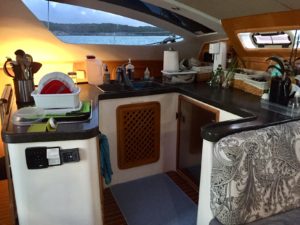
Until I quit my job, I was working 40-60 hours a week and writing 2-3 books a year. Needless to say, I rarely had time to cook or bake, two things I really enjoy. Now that I have the time, I’ve been experimenting with cooking aboard our boat. It’s not all that different from cooking on land, with the exception of the oven, which doesn’t get quite as hot as its full-size relative. That means turning your bread over to cook the bottom. No biggie. It still comes out tasty!

So what else is different?
1) Water. On a boat, you need to conserve water (our boat holds 120 gallons). This is especially true in the Bahamas, where most water is RO (reverse osmosis filtered sea-water). Water can run 50 cents a gallon, and although we have a watermaker, it only runs on the generator, which takes diesel. So boaters tend to use less water, especially when doing the dishes or showering.
I do a lot of one-pot meals for easier cleanup. And I’m having a blast since my daughter gave me a copy of a one-pot vegetarian cookbook.
Here’s the before and after for an Indonesian rice dinner I made on the stove:
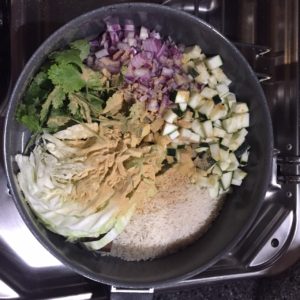
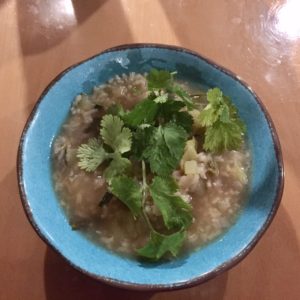
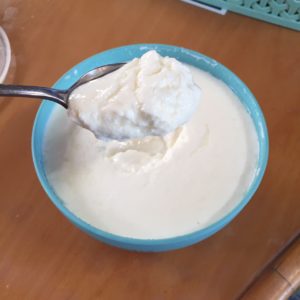
2) Availability of food. Things I’ve been used to finding in my neighborhood grocery store can be hard to come by in the Bahamas, or the prices are outrageously high (usually twice what you’d pay in the US). Science to the
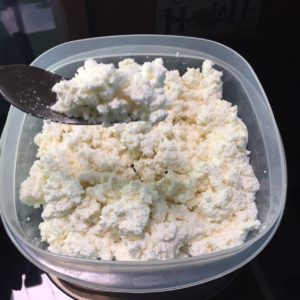
rescue! Instead of paying $10 for a container of yogurt, I made my own and, surprise, surprise, it was even better than store bought! I don’t have a yogurt maker, so I used a Thermos and it was super easy. Same goes for ricotta cheese. Who knew all you needed was to warm up milk and add vinegar? It’s delicious!
In making ricotta, I ended up with a lot of whey (the liquid that sits on the top of yogurt or a by-product of making cheese). First time I tossed it out. The second time, I found a recipe
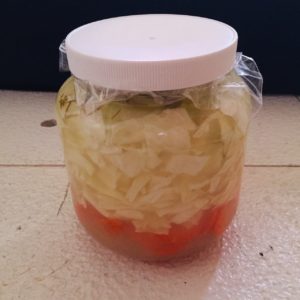
for picking vegetables with whey. The jury’s out on that one (at least for 3 more days), but I’m told it makes delicious pickles.
3) Space. Space is at a premium in a boat galley, especially in the refrigerator, which is dormitory-sized. What I never realized was that in the US we tend to refrigerate many things that don’t need refrigeration. Ketchup, lemon and lime juice, hot sauces, mustard, steak sauce, veggies, fruit, and bread don’t need to be kept cold. Even eggs can be kept unrefrigerated for more than a month, so long as they were never refrigerated to begin with. I tend to make yogurt every third day so that I have just enough for 3 breakfasts without filling up the fridge.
4) Time. I have SO much time to experiment, whether it’s figuring out how to use callaloo, a local leafy green that’s a cross between spinach and collards, or how to make my own sour cream. I’ve gotten really good at substituting in recipes, and we’ve been eating really well. Healthier too.
Someone asked me the other day if I had a bread-maker. I held up my hands in reply. Kneading bread really IS as stress-relieving as they say. And the bread is a million times better than store-bought. Much cheaper, too, since flour is inexpensive most everywhere we’ve sailed.
I’ll leave you with the recipe for Thermos yogurt, in case you feel adventurous. And if you’re curious about our travels, be sure to check out our sailing blog (with Shira’s not-so-sooper-seekrit-identity) here: https://www.sailblogs.com/member/alexibobsail. Until next time! -Shira
Thermos Yogurt
Any thermos will do, but the glass or metal ones tend to hold heat better. Wide mouth is best, but mine is a regular coffee-type thermos and it still works great.
Boil some water and fill and close the thermos to heat it up.
Heat whole milk (enough to fill your thermos to within 1-2″ from the top) on the stove to between 110 and 120 degrees. Be sure to use a cooking thermometer to check this, since if it’s too hot, the yogurt culture will die and too cold the culture won’t grow. If it’s too hot, let it cool a bit.
Stir in 2 tablespoons of active culture yogurt. Plain is best. I’ve also been told that yogurt probiotic drinks work well for yogurt making. There are dry starters available online, but I’ve never tried them. Be sure to look for yogurt that says it has live cultures in it. I used Greek yogurt and it came out great.
Pour the water out of the thermos and pour the cultured milk in. Close the cover and leave undisturbed for about 4 hours. It can take up to 8 hours to set sometimes, so if it’s not the right consistency, check it every hour until it is “set.” Once it’s the right thickness, pour it into a container and refrigerate. Don’t let it sit too long in the thermos after it’s ready or it can get very sour.
Be sure to save a few tablespoons of your yogurt to start the next batch. I’m told homemade starter works even better than store bought. Once you get the hang of yogurt-making, you can try this recipe with 2% or skim milk, but it may take longer to set and you may need more starter.
******
About Shira:
Shira Anthony was a professional opera singer in her last incarnation, performing roles in such operas as Tosca, Pagliacci, and La Traviata, among others. You can hear Shira sing an aria from a live performance of Puccini’s Tosca by clicking here: “Vissi d’arte”
Shira’s given up TV for evenings spent with her laptop, and she never goes anywhere without a pile of unread M/M romance on her Kindle. She can be found aboard Prelude, a 38’ catamaran sailboat, with her favorite sexy captain at the wheel.
Whether contemporary romance, high fantasy shifters, or time-traveling vampires, Shira writes what she loves and never writes a story without a HEA. Her Mermen of Ea trilogy book Into the Wind was named one of the best books of 2014 by both Scattered Thoughts and Rogue Words and Hearts on Fire Reviews, and was a finalist in the 2014 Goodreads M/M Romance Member’s Choice Awards. Her Blue Notes series of classical-music-themed gay romances was named one of Scattered Thoughts and Rogue Words’ best series of 2012, and the most recent book in the series, Dissonance, was named one of the best books of 2014 by Hearts on Fire Reviews. Her book A Solitary Man, coauthored with Aisling Mancy, won a 2016 Rainbow Award Honorable Mention for Best Gay Mystery/Thriller.
